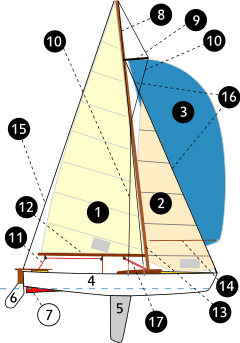Backstay
A backstay is a piece of standing rigging on a sailing vessel that runs from the mast to either its transom or rear quarter, counteracting the forestay and jib. It is an important sail trim control and has a direct effect on the shape of the mainsail and the headsail. Backstays are generally adjusted by block and tackle, hydraulic adjusters, or lines leading to winches.
Types

Backstays may be permanent or running. A permanent backstay is attached to the top of the mast. Running backstays appear in pairs attached about two-thirds of the way up the mast (sometimes at multiple locations along the length of the mast). In general, most modern sailboats will have a permanent backstay and some will have a permanent backstay combined with running backstays. Backstays are not always found on all vessels, especially smaller ones.
A permanent backstay is attached at the top of the mast and may or may not be readily adjustable. In a masthead rig, tensioning the permanent backstay will directly tension the forestay. This control is used to adjust the amount of "sag" in the headsail. In a fractional rig, tensioning the permanent backstay will have two effects: First, the forestay is tensioned (controls sag in headsail) and second, the mast bend is increased, particularly in the upper one-half to one-third of the mast. Increased mast bend tends to reduce the draft (camber) of the mainsail.
A running backstay always attaches to the mast at a point below the top of the mast and is generally used in conjunction with a permanent backstay. Running backstays are found on both masthead rigs and fractional rigs. There are some rigs for which running backstays may be used without a permanent backstay. This occurs most often where the mainsail has significant roach or a very large mainsail,especially combined with narrow hull beam. Gaff rigged boats invariably have running backstays with no permanent backstay. In both of these cases the mainsail extends aft of a line from masthead to stern, and so a permanent backstay would interfere with the operation of the sail. As a direct consequence of its attachment point (below the top of the mast) a running backstay is always adjustable, because it must be manually engaged and disengaged during every tack or jibe. Adjusting the tension on the running backstay has two effects: First, the forestay is tensioned (controls sag in headsail) and Second, mast bend is increased (the mast becomes more bent). The overall effect of tensioning the running backstay is a shallower mainsail (less camber) combined with a reduction in headsail sag.
If the running backstays leads to the mast where the forestay attaches, the effect of tensioning them will reduce sag in the headsail and second,increase mast bend and flatten the mainsail as a result. Both effects are desirable as the wind increases.
Backstays as antennas
On modern oceangoing yachts, the backstay is also commonly used as an antenna for Marine SSB radios and/or an amateur radio, accomplished by placing structural backstay insulators at either end of the backstay.